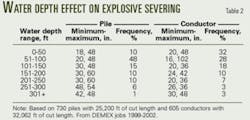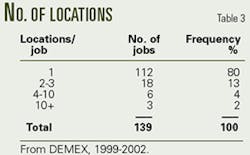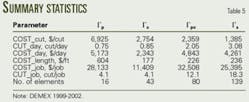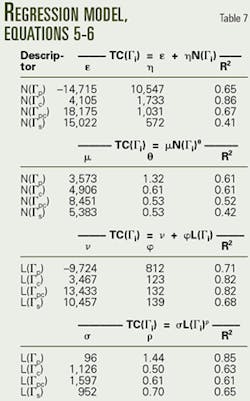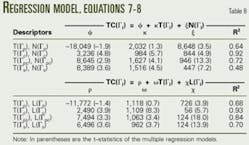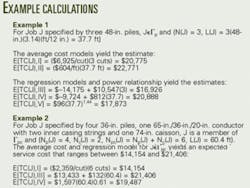Gulf of Mexico Decommissioning—Conclusion
An analysis of Gulf of Mexico decommissioning operations showed that severing platforms with explosives is a time-invariant and structure-dependent operation that provides contractors the advantage of essentially knowing costs prior to executing the job.
This concluding part of a five-part series on the cutting technology employed in decommissioning presents cost statistics and procedures for severing platforms with explosives.
The first part of this series appeared in OGJ, Sept. 27, p. 41. The other parts followed in the Oct. 4, p. 37; Oct. 18, p. 44; and Nov. 1, p. 37, issues.
Data source
The analysis compiled a database from 139 jobs in the gulf conducted between 1999-2002 by DEMEX AS and TEI Construction Services.
The sample set included 730 piles with a total 25,200 ft of cut length and 605 conductors with a total of 32,062 ft of cut length.
The 4-year time period ensures that the cost statistics reflect the current operating environment, and because DEMEX was involved in the majority of explosive removals during this time, the data are representative.
Descriptive statistics
Explosives have cut both piles and conductors and work well on all tubular members. Table 1 shows the diameter range of elements cut with explosives, and Table 2 lists the frequency of application of explosive as a function of water depth.
Explosive cutting occurs throughout all water depths and diameter ranges, but the tables show that most piles (83%) and conductors (95%) cut had a 42 in. or smaller OD. The drop-off in the frequency of explosive severance with increasing water depth reflects the nature of the structures removed.
Most jobs with explosives include only one site, but one in every five jobs involves crews dispatched to more locations (Table 3).
Table 4 shows that the percentage of elements severed on a first-shot basis tends to decrease with increasing element diameter, but the reliability of explosives forms the base line for severance operations.
Average cost
The analysis defines the cost to cut one pile or one conductor on a job that only involves piles or conductors as the cost of the job, AC(J), divided by the number of cuts performed (Equations 1-2 in the equation box).
In the equations, Np(J) counts the total number of piles and Nc(J) counts the total number of conductors of the job. Jobs that involve severing piles and conductors are counted and analyzed separately.
Similar relations are defined as follows:
COST_string (Γi)—Normalized cost to cut a string.
COST_cut(Γi)—Average cost to cut an element.
CUT_day(Γi)—Average number of cuts per day.
COST_day(Γi)—Average day rate.
COST_length (Γi)—Average cost per length of material cut.
The analysis defines the values for COST_cut, CUT_day, COST_day, and COST_length statistics according to the set(Γp (pile-only jobs),(Γc (conductor-only jobs), Γpc (pile and conductor-only jobs), and Γs (all jobs). Table 5 shows descriptive statistics on the value of COST_job and CUT_job within each category along with a count of the number of elements within each class.
Pile-only jobs represent a small fraction of the job type (11%), followed by conductor-only jobs (31%), and pile-conductor jobs (57%).
This result is not surprising. If the job requires explosive methods on one element, then it is likely that the job will include explosive charges on other elements as well. Also because conductors frequently require explosive severance, jobs with conductors that are severed with explosives also will include piles severed with explosives.
The data set reveals that combined pile and conductor jobs have the highest frequency for using explosives. Pile-only and conductor-only jobs have a lower frequency in cases where other cost-effective methods to sever piles (abrasive water jet) and conductors (mechanical and sand cutters) exist.
The job-type statistics also provide indirect evidence on the manner in which contractors perform decommissioning activities. In about 40% of severance operations, contractors perform pre-cut activities on the conductor and casing string, while in nearly 60% of the jobs, they perform no pre-cut activities and sever conductors and piles at the same time reflecting both the operator preference and structure configuration.
A typical pile-only and conductor-only job severs four elements on average, while pile-conductor jobs cut three times more pipe. The unit cost and time to perform a cut vary with the category.
From Table 5, the cost to cut piling on a pile-only job is $6,925/pile, while the cost to cut a conductor on a conductor-only job is $2,754/conductor. On a length cut, the cutting cost is $604/ft for a pile vs. $177/ft for a conductor.
The conductor cut has a lower cost because conductors typically contain several inner casing strings that when measured, add to the conductor cut length but do not require a greater explosive charge. Recall from Part 4 of this series that explosive-severance contracts typically charge on a per-element basis without regard to the number of inner casing strings. This is an important observation because cost relationships based on a weighted count of inner casing string or total cut length would not be a good descriptor variable for most jobs.
Pile-only and conductor-only jobs have a similar trend.
A conductor-only explosive cut was the least expensive of all the cutting operations on a total cost-per-day basis, while pile-conductor jobs had the lowest cost per cut. The direct cost to cut a string with explosives is about $1,400/string or $236/ft.
The total direct cost for explosive severance is about $5,000/day.
On site time
For a Job J, the contractor knows the structure characteristics (such as the number of conductors, piles, strings, and total cut length) prior to starting the job but only knows the time to complete the operation and return ashore after completing the job.
The analysis sought to establish a relationship, if any, between the time on site to complete the job, excluding weather delays, and the structure characteristics. Also the job may entail several delays besides weather that a subcontract cannot control such as barge preparation work, mechanical problems, well hangers, lifting time, time to jet tubes, etc. The analysis did not attempt to exclude or identify these factors.
Equations 3 and 4 provide a power relationship. Table 6 shows that the equations provide a poor fit, leading to the conclusion that prior knowledge of the structure does not nor cannot provide a reasonable basis to predict the expected time a cutting crew will be on site.
The functional relationship that includes the cut length is better than a simple count of tubular elements, but for the most part, the improvement is insufficient to construct a reliable predictor.
The on site time of a cutting job is a stochastic quantity that in general cannot be predicted before the job is performed.
Total cost
The two primary variables that determine the cost of explosive service are the day-rate charged for the personnel and the configuration charge related to the number of cuts made. The performance, reliability, and speed of explosive cutting are calculated from the value of T(J), while N(J) and L(J) primarily determine the job specification.
The analysis determines the total cost of an explosive cut in stages using one and two-variable models based on T(Γi), N(Γi), and L(Γi).
The one-variable models (Equations 5 and 6) explain the total cost through an enumeration of the number of elements to be cut, N(Γi), and a calculation of the total length of cut that needs to be made, L(Γi).
The two-variable models incorporate the on site time of the cutting crew, T(Γi), in the form of Equations 7 and 8. Tables 7 and 8 show the results of the model.
The models show a fairly strong relationship between the total job cost and the structure configuration described by N(Γi) and L(Γi). The regression modeling indicates that a contractor can predict the total cost to cut a structure with explosives before actually performing the job and essentially without regard to the length of time involved to perform the operation.
Of course for each job, cutting crews charge a day rate for their personnel, and therefore, the total cost for each job will involve time, but the regression models indicate that the day-rate charges are secondary and do not play a major role in the cost to perform the service. The relatively high value of the model fits using just one descriptor variable supports this conclusion.
This result also shows, as expected, that the regression models that include a normalized casing string count generally lead to a poor fit.
The cost to perform an explosive removal is essentially invariant with respect to time, and this time invariance is the primary reason for the popularity (and expected continued popularity) of explosive severance in an increasingly regulated environment.
With explosive severance, contractors and subcontractors know what a job will cost before performing the job, and this is extremely valuable from an operational and financial perspective because it eliminates a significant uncertainty in the operating environment.
Other severance techniques have neither the performance reliability nor the operational certainty of explosive methods, and thus may be more expensive and riskier to employ.
Table 8 shows multiple regression models built from the variables T(Γi), N(Γi), and L(Γi). The inclusion of on site time improves the model fits indicating that the variable is a relevant factor, but because the time to perform a job is uncertain from the outset, even if the model fits improved dramatically, which they do not, the application of the relationship remains somewhat limited.
Average cost
Water depth has a weak positive correlation with the average cost to perform explosive severance.
As the water depth increases, the time in and out of the hole increases and the amount of detonating cord, which includes handling and trucking expenses, increases cost. The effect of water depth on charges that weigh less than 100 lb does not vary significantly because contractors lower these charges with rope and incur minimal detonating cord cost.1
Large piles in deep water that require 1-in. diameter or greater cable can significantly affect total cost. But because the database includes mostly jobs within a 300-ft water depth, the analysis may not detect the influence of water depth on average cost.
With the available data, the analysis indicates that water depth is not a relevant factor or cost driver for explosive severance of structures in water depth less than 300 ft.
Cost estimation
The average cost per cut provides a quick means for estimating the direct cost of explosive cutting services.
The following three steps use the average-cost multipliers to provide a quick estimate of the value and cost of a job J.
1. Classify the job within its appropriate category (Γip Γc, Γpc, or Γs).
2. Compute the total number of cuts per class or the total cut length.
3. Evaluate the expected total cost of the job, E[TC(J)], with either Equation 9 or 10.
One can determine the value of COST_cut(Γi) and COST_length(Γi) from Table 5, with N(J) and L(J) known from the job specification.
Table 7 depicts an alternative realization of the expected cost of job JεΓi based on the power relations and regression models (Equations 11 and 12).
The accompanying box (p. 51) provides example calculations for estimating the cost of severing platform elements with explosives..
Acknowledgments
Many industry and government personnel provided generously of their time and expertise for this series. We especially thank Sim Courville and Jeff Cole, Well Cut Inc.; John Kenny, Gary DeMarsh, and Russel Wilcox, DEMEX AS; Aly Hakam, ChevronTexaco Corp.; Ron Twachtman and Esau Velazquez, Twachtman Synder & Bryd Inc.; Nick Jones, Oil States MCS; Svein Solversen, Norse Cutting and Abandonment AS; Jon Calahan and Michael Leska, Superior Energy Services Inc.; and Jeff Steele, Rodriguez Consultants Inc..
Tommy Broussard, Jeff Childs, and Vicki Zatarian, US Minerals Management Service, also provided critical information and useful feedback on various parts of these articles.
Reference
1.DeMarsh, G., "The use of explosives in decommissioning and salvage," OTC 12023, Houston, May 1-4, 2000.


